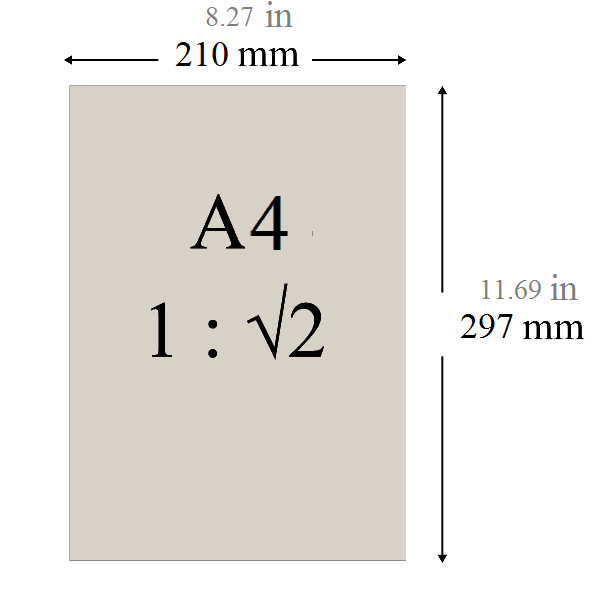In our daily lives, whether in offices, schools, or at home, A4 paper is one of the most commonly used items. But have you ever wondered, what exactly is an A4 paper, what size is it, and why has it become the most prevalent paper size around the world? Let's dive into the world of A4 paper to find out.
At its core, A4 is a specific rectangular paper size defined by the international ISO 216 standard. Its dimensions are precise:
210 millimeters wide (approx. 8.27 inches)
297 millimeters tall (approx. 11.69 inches)
What makes A4 truly special isn't just these specific measurements, but its place within a brilliantly logical system. A4 is part of the A-series, which starts with A0. An A0 sheet has an area of exactly one square meter (841mm x 1189mm). The magic lies in the aspect ratio: every size in the A-series has a width-to-height ratio of 1:√2 (approximately 1:1.4142).
This ratio is key. When you cut an A0 sheet exactly in half along its longer side, you get two A1 sheets. Cut an A1 sheet in half, you get two A2 sheets, and so on. Therefore, A4 is simply one-sixteenth of an A0 sheet. This inherent scalability ensures perfect proportions and minimal waste when scaling documents up or down – an A4 document reduced to A5 fits perfectly within the A5 dimensions without cropping or awkward margins.

A4 dominates globally for three key reasons:
1. Practical Aspect Ratio
1:√2 ratio ensures no layout distortion when scaling between A-series sizes (e.g., A4 to A3/A5).
Ideal for printing, photocopying, and design—content fits seamlessly across sizes without cropping or stretching.
2. International Standardization
Adopted by 95% of countries (except the US/Canada, which use Letter size).
Facilitates global document sharing: no complex conversions needed for cross-border use in business, academia, and communication.
3. Convenient Size
210mm × 297mm strikes a balance:
Large enough for detailed content (reports, essays, brochures).
Compact enough for easy handling: fits the average hand, standard file folders, printers, and backpacks.
Versatile: used for letters, presentations, and even posters (when tiled).
The production of A4 paper involves a series of well - coordinated processes in an A4 producing line.
1. Raw Material Preparation
The process starts with the preparation of raw materials, mainly wood pulp or recycled paper pulp. The pulp is processed to remove impurities and is then formed into large rolls of paper on a paper machine. These large rolls, known as parent rolls, can be several meters in width and are typically much larger than the final A4 size.
2. Cutting and Trimming
The parent rolls are then transported to a cutting section of the A4 producing line. Here, they are cut into smaller, more manageable rolls or sheets using precision cutting equipment. For A4 paper, the large sheets are first cut into the appropriate size based on the A4 dimensions. Specialized cutting blades ensure that the edges are straight and the dimensions are accurate to within tight tolerances as per the ISO 216 standard.
3. Quality Control
Throughout the production process, strict quality control measures are in place. Sensors and inspection systems check the dimensions, thickness, weight, and surface quality of the paper. Any sheets that do not meet the standards are removed from the production line to ensure that only high - quality A4 paper reaches the market.
A4 paper is far more than just a random rectangle. It is the cornerstone of an ingeniously designed, globally recognized system (ISO 216) built on mathematical harmony (the 1:√2 ratio). This design delivers unparalleled practical benefits for scaling, production efficiency, and international compatibility. From the giant rolls on the A4 producing line to the sheet in your printer tray, A4's standardization powers the smooth flow of information worldwide, making it truly the most common paper size for excellent reasons. Its simple dimensions belie the complex efficiency and global coordination it represents.
Q: How does A4 compare to Letter size paper?
A: Letter size paper, which is commonly used in the United States and Canada, has dimensions of 8.5 inches by 11 inches (approximately 216mm x 279mm). So, A4 is slightly longer and narrower than Letter size. The main difference lies in their usage; while A4 is the international standard, Letter size is the dominant standard in North America. This can sometimes cause issues when documents need to be exchanged between these regions, but most modern software and printers can handle both sizes with appropriate settings.
Q: What is the weight of A4 paper?
A: The weight of A4 paper is typically measured in grams per square meter (g/m²). Common weights for A4 paper range from 70g/m² to 120g/m². Lighter weights like 70g/m² or 80g/m² are commonly used for everyday printing and writing, such as in office documents and school assignments. Heavier weights, such as 100g/m² or more, are used for more premium applications like brochures, flyers, and business cards, as they feel more substantial and have a better quality appearance.
Q: Can A4 paper be used in all printers?
A: In most cases, yes. Most modern printers, whether they are inkjet, laser, or multifunction printers, are designed to handle A4 paper as it is the international standard. However, it is always a good idea to check the printer's specifications to ensure that it supports the paper size and type you want to use. Some older printers or specialized printers may have limitations, but these are becoming increasingly rare as A4 has become the default paper size for most printing applications.

GET A QUOTE